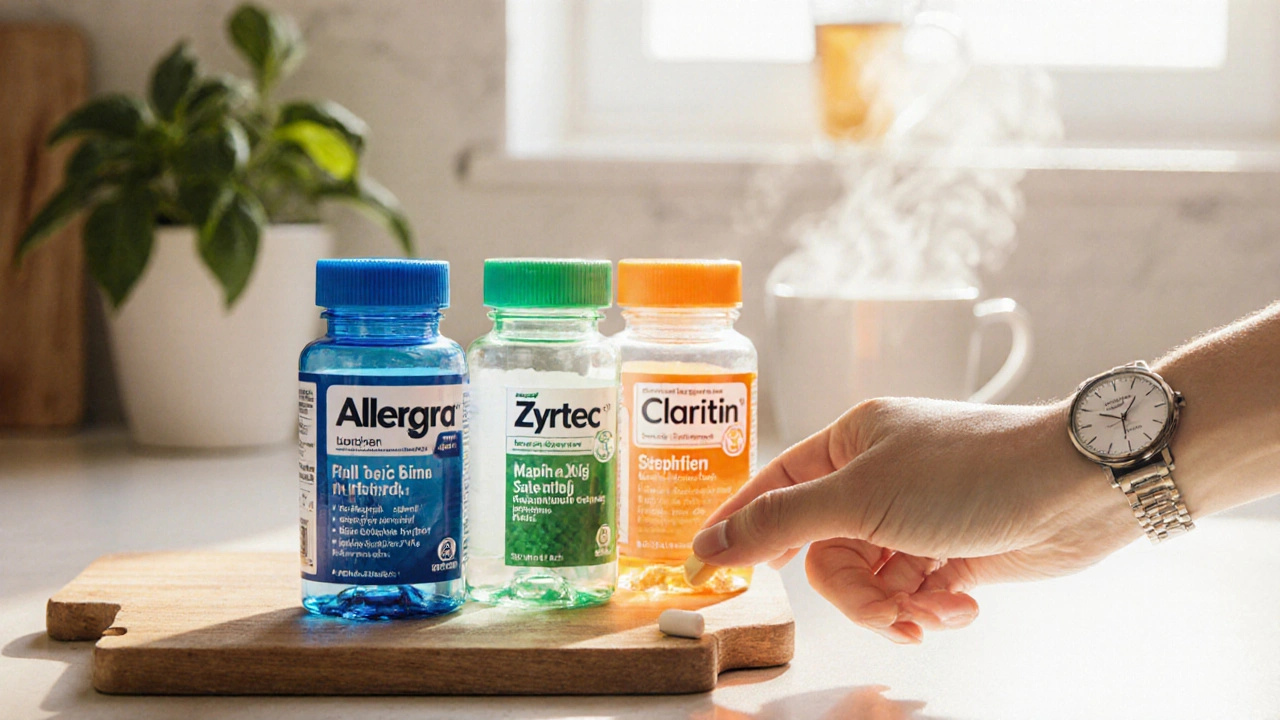Antihistamine Selector
Select Your Symptoms
Do You Need Fast Relief?
Are You Concerned About Drowsiness?
What Is Your Lifestyle?
When allergy season hits, the first question is: which antihistamine will keep me breathing easy without making me feel drowsy? Allegra is the brand name for fexofenadine, a second‑generation H1 antihistamine that promises 24‑hour relief with minimal sedation.
Quick Take
- Allegra (fexofenadine) works fast, lasts about 24hours, and rarely causes drowsiness.
- Cetirizine and levocetirizine are slightly more potent but may cause mild sleepiness.
- Loratadine and desloratadine are good all‑day options with a very low sedation risk.
- Diphenhydramine works instantly but lasts only 4-6hours and is highly sedating.
- Choose based on speed, duration, side‑effect tolerance, and any pregnancy or age restrictions.
How Allegra (Fexofenadine) Works
Fexofenadine blocks the H1 histamine receptor, preventing histamine released during an allergic reaction from binding and triggering the classic sneeze‑runny‑nose‑itchy‑eyes cascade. Because it’s a second‑generation molecule, it stays largely out of the brain, which is why most people can take it during work or school without feeling sleepy.
Key Characteristics of Allegra
- Typical adult dose: 180mg once daily (or 60mg three times a day for children 6‑11years).
- Onset of action: 1‑2hours.
- Duration: up to 24hours.
- Sedation level: very low - clinical scales rate it 0-1/10.
- Pregnancy safety: Category B in the US; generally considered safe after the first trimester.
- Drug interactions: Antacids, fruit juices, and some antibiotics can reduce absorption.
Most Common Alternatives
Below are the top five over‑the‑counter antihistamines that people compare with Allegra.
Cetirizine is a second‑generation H1 blocker sold as Zyrtec - well‑known for fast relief but can cause mild drowsiness in 10‑20% of users.
Loratadine is the active ingredient in Claritin, another low‑sedation antihistamine - a solid all‑day choice with a slightly slower onset.
Desloratadine is the active metabolite of loratadine, marketed as Clarinex - offers the longest half‑life and virtually no sedation.
Levocetirizine is the active enantiomer of cetirizine, sold as Xyzal - slightly stronger than cetirizine with a similar side‑effect profile.
Diphenhydramine is the classic first‑generation antihistamine found in Benadryl - rapid action but heavy sedation.
Side‑Effect Snapshot
All antihistamines share the same primary goal: stop histamine. Their differences lie in how they reach the brain and how long they stay in the system.
- Allegra: Rare dry mouth, headache; virtually no drowsiness.
- Cetirizine: Mild drowsiness, occasional dry mouth.
- Loratadine: Minimal drowsiness, occasional headache.
- Desloratadine: Almost no sedation, rare headache.
- Levocetirizine: Slight drowsiness in sensitive users.
- Diphenhydramine: Strong drowsiness, dry mouth, urinary retention.
Direct Comparison Table
| Drug | Onset | Duration | Typical Adult Dose | Sedation (0‑10) | Pregnancy Category |
|---|---|---|---|---|---|
| Allegra | 1‑2h | 24h | 180mg once daily | 0‑1 | B |
| Cetirizine | 30‑60min | 24h | 10mg once daily | 2‑3 | B |
| Loratadine | 1‑3h | 24h | 10mg once daily | 0‑1 | B |
| Desloratadine | 1‑2h | 24h (up to 30h) | 5mg once daily | 0‑1 | B |
| Levocetirizine | 30‑60min | 24h | 5mg once daily | 2‑3 | B |
| Diphenhydramine | 15‑30min | 4‑6h | 25‑50mg every 4‑6h | 7‑9 | C |

Which Antihistamine Fits Your Lifestyle?
Allegra vs alternatives isn’t just a lab test - it’s about daily life. Here are a few common scenarios and the best pick for each.
- Need all‑day work focus: Allegra, Loratadine, or Desloratadine - they won’t slow you down.
- Fast relief for a sudden pollen spike: Cetirizine or Levocetirizine act within an hour.
- Traveling at night and want to sleep: Diphenhydramine can double as a sleep aid.
- Pregnant or planning pregnancy: All listed drugs except Diphenhydramine are Category B; discuss with your GP.
- Child under 6: Only certain liquid formulations of cetirizine and loratadine are approved - never give adult doses.
Cost and Availability (2025 Snapshot)
Pricing varies by brand, pack size, and pharmacy. In the UK market (average 2025 figures):
- Allegra 180mg - £6.99 for 30 tablets.
- Cetirizine 10mg - £4.50 for 30 tablets.
- Loratadine 10mg - £3.80 for 30 tablets.
- Desloratadine 5mg - £7.20 for 30 tablets.
- Levocetirizine 5mg - £8.00 for 30 tablets.
- Diphenhydramine 25mg - £2.30 for 20 tablets (but you’ll need several doses).
All are available over the counter in most UK supermarkets, pharmacies, and online retailers. Some premium “no‑drowsy” versions price higher, but the generic equivalents work just as well.
Potential Pitfalls & How to Avoid Them
- Food interactions: Taking Allegra with grapefruit juice or antacids can cut absorption by up to 50%. Wait two hours after eating citrus juices.
- Over‑use: More isn’t better. Stick to the recommended daily dose; excess can cause heart palpitations.
- Mixing with alcohol: Even low‑sedation antihistamines can heighten alcohol’s drowsy effect.
- Kid safety: Never give adult tablets to children; use age‑appropriate liquid drops.
- Medical conditions: If you have kidney disease, dose adjustments for fexofenadine may be needed.
When to See a Doctor
If you experience any of the following, book a GP appointment:
- Symptoms persist beyond two weeks despite daily antihistamine use.
- Severe facial swelling, throat tightness, or difficulty breathing - could be anaphylaxis.
- Unusual cardiac rhythm, severe headache, or persistent dry mouth that interferes with eating.
- Need for antihistamines while pregnant - a clinician can confirm safety.
Bottom Line: Picking the Right Antihistamine
For most adults who want 24‑hour relief without any yawning, Allegra (fexofenadine) remains the go‑to option. If you need a faster‑acting pill or are okay with a touch of sleepiness, cetirizine or levocetirizine are solid alternatives. Loratadine and desloratadine sit comfortably in the low‑sedation camp, while diphenhydramine is best saved for short‑term, nighttime relief.
Frequently Asked Questions
Can I take Allegra and a daily multivitamin together?
Yes. Most multivitamins don’t contain the fruit‑juice components that interfere with fexofenadine absorption, so they’re safe to combine.
Is it okay to switch from Cetirizine to Allegra mid‑season?
Absolutely. There’s no wash‑out period required. Just stop the cetirizine and start Allegra at the recommended dose.
Will Allegra protect me from pet allergies?
It helps with the sneezing, runny nose, and itchy eyes caused by pet dander, but it won’t stop an allergic skin rash. You’ll still need to limit exposure.
Can I take Allegra if I have high blood pressure?
Fexofenadine does not raise blood pressure, so it’s generally safe. However, always check with your GP if you’re on multiple cardiovascular meds.
Why does my doctor sometimes recommend a nasal spray instead of a tablet?
Nasal sprays deliver antihistamine or steroid directly to the nasal lining, providing quicker relief for severe congestion. Tablets work systemically and are better for broader symptoms like itchy eyes.
Next Steps
1. Identify your primary symptom driver - nose, eyes, or sleep. 2. Match that need to the drug profile in the table above. 3. Grab the cheapest reputable brand (generic is fine) and try a 7‑day trial. 4. If you notice drowsiness or inadequate relief, switch to the next best alternative. 5. Keep a short symptom diary; if nothing works after two weeks, book a GP visit.


Comments
Brandon Phipps
Reading through the Allegra vs other antihistamines post was like taking a guided tour through the allergy pharmacy aisle, and I appreciated the detail. The author laid out the onset, duration, and sedation scores in a clear table that even a busy professional can skim. I especially liked the note about food interactions, because many people don’t realize grapefruit juice can cut absorption by half. The comparison of fexofenadine’s low 0‑1 sedation rating with cetirizine’s 2‑3 really drives home why Allegra is favored for work‑focused folks. The section on pregnancy safety being category B after the first trimester is a crucial reassurance for expectant mothers. Also, the cost snapshot for the UK market gives a realistic idea of what to expect at the pharmacy counter. The author’s bullet points about side‑effects make it easy to weigh dry mouth versus occasional headache. I found the lifestyle scenarios helpful – fast relief for pollen spikes, sleep aid at night, and the all‑day focus angle all map nicely onto daily routines. The mention of kidney disease dosing adjustments for fexofenadine is a nice safety reminder that many overlook. The FAQ about switching from cetirizine to Allegra mid‑season underscores the lack of a wash‑out period, which simplifies treatment changes. The advice to keep a symptom diary for two weeks before seeing a GP is practical and evidence‑based. Readers will benefit from the tip to avoid antacids and citrus juices within two hours of dosing. The discussion of nasal spray versus tablet options helps clarify why some patients need combination therapy for congestion. Highlighting that diphenhydramine is best saved for short‑term nighttime relief aligns with its sedating profile. Overall, the article balances scientific data with real‑world tips, making it a solid reference for anyone navigating the antihistamine market.
On September 29, 2025 AT 18:02
yogesh Bhati
The dance of histamine in our sinuses mirrors the cosmic swirl of thoughts, and Allegra appears as the quiet philosopher who refuses to wake the mind. Yet, a tiny typo sneaks in: "allegra" should be capitalized like a proper name. The table feels like a map of constellations, each drug a star with its own brightness and lull.
On September 30, 2025 AT 10:42
Akinde Tope Henry
Allegra good for work no drowsiness.
On October 1, 2025 AT 03:22
Brian Latham
Meh, same old stuff.
On October 1, 2025 AT 20:02
Barbara Todd
While the overview is thorough, the emphasis on cost could use a note about generic availability, which often brings the price down dramatically.
On October 2, 2025 AT 12:42
nica torres
Great job breaking it down! This is exactly the kind of info that helps people stay active and sneeze‑free during marathon study sessions.
On October 3, 2025 AT 05:22
Dean Marrinan
😂 Classic lazy‑critic vibe, but hey, at least we know the price tags now. Thanks for the cheap‑ish list!
On October 3, 2025 AT 22:02
Oluseyi Anani
One extra tip: for those taking Allegra with other meds, spacing it two hours apart from antibiotics like azithromycin helps maintain its absorption efficiency.
On October 4, 2025 AT 14:42
Jeremy Wolfe
Remember, consistency is key – taking your antihistamine at the same time each day maximizes the 24‑hour coverage and keeps symptoms from sneaking back.
On October 5, 2025 AT 07:22
Rahul yadav
Allegra does its job, but for those who need a quicker kick, cetirizine’s half‑hour onset can be a lifesaver during sudden pollen bursts.
On October 6, 2025 AT 00:02
SHASHIKANT YADAV
I appreciate the clear dosing chart; just a heads‑up that kids under six need pediatric formulations, which are often liquid drops rather than tablets.
On October 6, 2025 AT 16:42
Ryan Pitt
Allegra stays awake, so you stay awake.
On October 7, 2025 AT 09:22
Jami Johnson
The drama of allergy season meets its match in fexofenadine; a hero that battles sneezes without the villainous side‑effects.
On October 8, 2025 AT 02:02
Kasey Krug
The article is comprehensive, though the term "sedation (0‑10)" could be clarified as an average score from clinical trials rather than a subjective scale.
On October 8, 2025 AT 18:42
jake cole
Honestly, if you can’t afford the brand name, just grab the generic – the chemistry’s the same, and the marketing hype adds no therapeutic value.
On October 9, 2025 AT 11:22